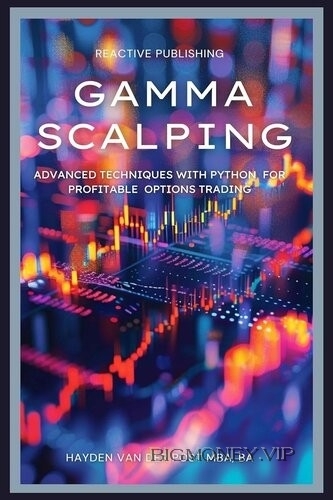Gamma Scalping Advanced Techniques with Python for Profitable Options Trading by Hayden Van Der Post MBA. BA

CHAPTER 1:
INTRODUCTION TO
GAMMA SCALPING
Gamma scalping is an intricate trading strategy employed by
sophisticated traders to manage risk and capture profits in the options
market. At its core, this strategy involves dynamically adjusting the
delta of an options portfolio to maintain a neutral stance, capitalizing on the
volatility of the underlying asset. By understanding the key concepts of
gamma, delta, and other related Greeks, traders can effectively navigate and
exploit market movements to their advantage.
Understanding Gamma and Delta
To grasp gamma scalping, one must first understand the fundamental
concepts of gamma and delta. Delta represents the rate of change of an
option's price relative to the price movement of the underlying asset.
Essentially, it measures the sensitivity of an option's value to changes in the
price of the stock. A delta of 0.5, for instance, indicates that the option's
price is expected to move by $0.50 for every $1 change in the stock's price.
Gamma, on the other hand, measures the rate of change of delta with
respect to the underlying asset's price. In simpler terms, gamma indicates
how much the delta will change for a given move in the stock's price. High
gamma implies that delta will change significantly with small movements
in the underlying asset, necessitating frequent adjustments to maintain a
delta-neutral position.
Delta-Neutral Strategy
The essence of gamma scalping lies in maintaining a delta-neutral position.
This means that the total delta of the portfolio is kept as close to zero as
possible, thereby reducing exposure to directional movements of the
underlying asset. By doing this, traders can focus on capturing profits from
the volatility of the asset rather than its directional movement.
To achieve delta-neutrality, traders continuously buy or sell the underlying
asset in response to changes in its price. When the price moves up, delta
increases, necessitating the sale of the underlying asset to bring delta back
to zero. Conversely, when the price drops, delta decreases, requiring the
purchase of the underlying asset. This constant rebalancing is where the
term "scalping" comes into play, as traders are effectively scalping small
profits from the frequent buying and selling.
Profiting from Volatility
Gamma scalping thrives on volatility. When the underlying asset exhibits
significant price fluctuations, the frequent adjustments to maintain delta-
neutrality generate a series of small profits. These profits accumulate over
time, providing a steady stream of income for the trader. In periods of low
volatility, the strategy may yield fewer opportunities, but the fundamental
principle remains the same – maintaining delta-neutrality and capturing
profits from the underlying asset's movements.
To illustrate, consider a simple example with an options portfolio consisting
of a single call option. Suppose the call option has a delta of 0.5 and a
gamma of 0.1. If the underlying stock price increases by $1, the call
option's delta will increase to 0.6 (0.5 + 0.1). To maintain delta-neutrality,
the trader would sell a portion of the underlying stock to offset the increase
in delta. Conversely, if the stock price decreases by $1, the delta would drop
to 0.4, prompting the trader to buy more of the underlying stock. These




